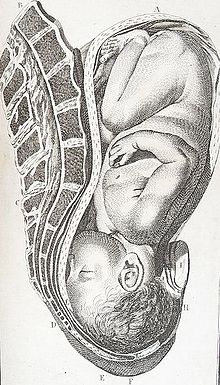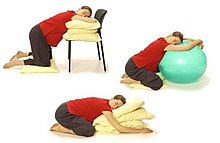

Back labor (less commonly called posterior labor [1] [2]) is a term referring to sensations of pain or discomfort that occur in the lower back, just above the tailbone, to a mother during childbirth. [3]
Back labor may be noted when the baby is face up in the birth canal (occiput posterior), and not face down, so that the back of the baby's skull ( occiput) is pushed against the mother's sacrum. However back labor can also occur when the baby is in a different position. [3] The discomfort is often noted to be intensely painful, and may not completely abate between contractions. [4] Whether back labor will occur cannot be predicted. Reports of how many mothers experience back labor vary, [5] though estimates in the range of 30% are common. [6] [7]
Actions that have been suggested to ameliorate back labor include physical activity, changing positions, [8] back rubbing, water massage, application of hot or cold to the lower back, use of a birthing ball [9] and medication including an epidural. [3] [10] Some research has suggested that injecting sterile water into the lower back may provide pain relief, but there is no consensus that it actually helps. [11]
See also
References
- ^ Moore, Mary Lou & Ora Strickland, Realities in Childbearing, p. 398 (1978) (using term "posterior labor")
- ^ El Halta, Valerie Posterior Labor---A pain in the back! Archived 2016-10-16 at the Wayback Machine, ICAN Clarion 1996; 2(1)
- ^ a b c Harms, Rogert W. Does back labor really happen?, mayoclinic.com, Retrieved 8 September 2014
- ^ Klossner, N. Jayne. Introductory Nursing, Vol. 1, pp. 190, 432-33 (2006)
- ^ Lieberman, Adrienne B. Easing Labor Pain: The Complete Guide to a More Comfortable and Rewarding Birth, p. 17 (1992) (This 1992 book says childhood educators typically cite 25%)
- ^ Curtis, Glade B. & Schuler, Judith. Your Pregnancy After 35: Revised Edition, p. 290 (2001)
- ^ Melzack, R. & D. Schaffelberg. Low-back pain during labor, Am J. Obstet Gynecol., 1987 Apr; 156 (4):901-05 (abstract) (1987 finding that "continuous low-back pain is severe and is reported by about 33% of women during labor.")
- ^ Simkin, P. The fetal occiput posterior position: state of the science and a new perspective, Birth 2010 Mar; 37(1)l 61-71
- ^ (25 July 2013). Positions and comfort measures to easy back labor, allparenting.com
- ^ Murkoff, Heidi & Sharon Mazel. What to Expect When You're Expecting, p. 367-368 (4th ed. 2008)
- ^ Derry, S.; Straube, S.; Moore, RA.; Hancock, H.; Collins, SL. (2012). Derry, Sheena (ed.). "Intracutaneous or subcutaneous sterile water injection compared with blinded controls for pain management in labour". Cochrane Database Syst Rev. 1: CD009107. doi: 10.1002/14651858.CD009107.pub2. PMID 22258999.